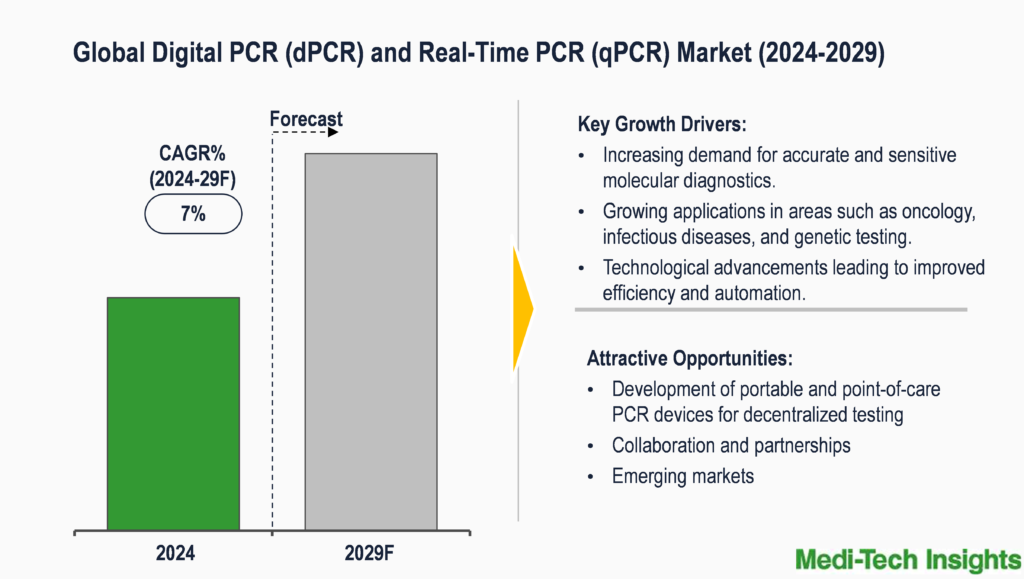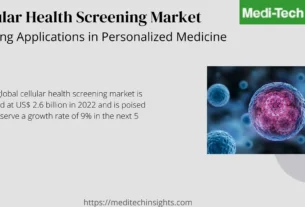Some of the key factors driving the market for digital PCR (dPCR) and real-time PCR (qPCR) include the rising prevalence of chronic diseases, which is driving the need for precise diagnostic tools. Other factors include growing applications in oncology, infectious diseases, and genetic testing; technological advancements leading to improved efficiency and automation; and government initiatives and funding support for genomic research and personalized medicine.
The digital PCR (dPCR) and real-time PCR (qPCR) market is characterized by the presence of major companies like Becton, Dickinson and Company (US), Danaher Corporation (US), F. Hoffmann-La Roche Ltd (Switzerland), Qiagen (Germany), Bio-Rad Laboratories, Inc. (US), Agilent Technologies, Inc. (US), and Thermo Fisher Scientific, Inc. (US).
Get Detailed Insights on Digital PCR (dPCR) and Real-Time PCR (qPCR) Market Report with a Sample PDF @ https://meditechinsights.com/digital-pcr-dpcr-and-real-time-pcr-qpcr-market/request-sample/
In molecular biology, Real-Time PCR, also known as quantitative PCR (qPCR), and Digital PCR (dPCR) are sophisticated methods for accurately detecting and quantifying nucleic acids. Both methods provide incredibly precise and sensitive detecting capabilities. The third generation of PCR, known as digital PCR, divides a sample of DNA, cDNA, or RNA into several separate microreactions, allowing for absolute quantification. While some microreactions include one or more molecules, some don’t. Every microreaction is separately amplified and analyzed using PCR. Negative microreactions can be identified from positive ones by looking for amplified products in them. By measuring the number of positive responses, the initial copy number and density of target DNA may be determined using Poisson statistics. Real-time PCR allows monitoring of the PCR progress in actual time. qPCR quantifies products with standard curves and provides low tolerance to interfering substances. It measures the fraction of negative microreactions to determine absolute copies, unlike traditional PCR that collects results after the reaction is complete. In addition to improved accuracy, sensitivity, and rapidity, one of the principal advantages of the real-time PCR over basic PCR is that this technique provides a reliable quantification relationship between the number of starting target sequences (before the amplification by PCR) and the amount of amplicon accumulated in a particular PCR cycle.
Expanding uses of dPCR and qPCR in infectious illnesses, genetic diagnostics, and cancer to drive market demand
Real-Time PCR (qPCR) and Digital PCR (dPCR) are finding increasing use in a number of sectors, such as genetic testing, infectious illnesses, and cancer. These sophisticated PCR methods are essential in oncology because they enable the identification of genetic markers linked to cancer diagnosis, the quantification of copy number variations (CNV), and the detection of uncommon mutations in cancer biopsy samples. For example, dPCR plays a critical role in identifying small DNA targets such as point mutations and chromosomal translocations, which helps with accurate cancer diagnosis and microbial resistance tracking. These cutting-edge PCR methods are essential to oncology because they help identify and track cancer biomarkers, which in turn helps with early diagnosis, prognosis, and therapy selection. For instance, studies have shown that Real-Time PCR assays targeting specific genetic mutations, such as BRAF V600E in melanoma or epidermal growth factor receptor (EGFR) mutations in lung cancer, have significantly improved patient outcomes by guiding targeted therapies (Source: NCBI). This enables earlier diagnosis and targeted therapies.
When it comes to infectious illnesses, circulating tumour DNA (ctDNA) in blood samples can be detected using liquid biopsies, which are less intrusive methods of monitoring the condition. These techniques are vital for assessing viral loads and tracking microbiological infections. dPCR and Real-Time PCR are essential instruments for the quick and precise identification of pathogens, such as bacteria, viruses, and parasites. Real-Time PCR-based assays have proven essential for identifying infections, tracking the spread of disease, and evaluating the effectiveness of public health measures, particularly during the COVID-19 pandemic. It is essential for identifying viruses like HIV (sensitivity surpassing 99%) because of its speed and capacity to track the course of a disease in real time (Source: NCBI).
Moreover, in genetic testing, both dPCR and qPCR are essential for gene expression analysis, miRNA expression profiling, and GMO detection by providing accurate quantification of gene expression levels and detecting genetically modified organisms in crops for regulatory compliance. These techniques enable precise quantification of gene expression levels, identification of genetic variants, and screening for hereditary diseases. With their sensitivity, specificity, and ability to analyze multiple targets simultaneously, dPCR and Real-Time PCR are poised to continue driving innovation in personalized medicine and precision diagnostics. qPCR is used in non-invasive prenatal testing (NIPT) to identify chromosomal abnormalities in foetuses with high accuracy (>99%) ((Source: NCBI)
Due to factors such the increasing prevalence of target infectious illnesses, genetic abnormalities, ongoing improvements in PCR technologies, and the growing role of PCR in biomarker identification, the market for these technologies is anticipated to develop rapidly. Worldwide molecular diagnostics are being revolutionized by the accuracy, sensitivity, and absolute quantification capabilities of dPCR and qPCR, which are propelling their use in a variety of applications within the domains of infectious diseases, cancer, and genetic testing. The applications of dPCR and Real-Time PCR are anticipated to develop further, propelling market expansion and innovation in healthcare, as our understanding of the genetic components underlying illnesses deepens and the desire for targeted treatments and tailored treatment techniques increases.
Important tactics used by labs and market participants
Through the integration of patient-specific genetic data, digital PCR and real-time PCR are enabling precision medicine and revolutionizing the healthcare industry. There is hope for better results and less healthcare costs with this move toward individualized treatment plans. The age of genomic medicine is being ushered in by the combination of dPCR, qPCR, and CRISPR technologies, which enable tailored molecular therapeutics. These developments provide producers a competitive advantage, motivating top companies to keep making investments in the creation of new goods and growing their worldwide presence. The goal of this strategy objective is to improve their standing in this expanding industry. Some of the latest advancements are noted below-
· In In April 2023, Qiagen launched three new kits for use on its QIAcuity systems and a major new software update designed to expand the portfolio of applications for use of digital PCR technology in areas like cell and gene therapies, DNA and RNA quantification, as well as food and pharmaceuticals safety
· Roche introduced the Digital LightCycler, a digital polymerase chain reaction (PCR) instrument, in August 2023. In addition to properly quantifying minuscule quantities of certain DNA and RNA targets that are normally undetectable by traditional PCR techniques, this next-generation device identifies illness.
· Thermo Fisher Scientific introduced their TaqPath PCR kits for Applied Biosystems in February 2023. These kits are intended for use in the detection of infectious illnesses such HIV, M. tuberculosis complex (MTB), hepatitis B, hepatitis C, and MTB MDR.
The global dPCR and qPCR market has the potential to grow at a significant rate despite obstacles like the high cost of reagents and equipment, the complexity of data analysis and interpretation, and the difficulties in integrating these tests into current laboratory workflows. These obstacles are expected to be exacerbated in the coming years by the rising prevalence of chronic diseases, which will increase the demand for accurate diagnostic tools, government initiatives and funding support for genomic research and personalized medicine, and technological advancements that will increase efficiency and automation.
About Medi-Tech Insights
Medi-Tech Insights is a healthcare-focused business research & insights firm. Our clients include Fortune 500 companies, blue-chip investors & hyper-growth start-ups. We have successfully completed 100+ projects in Digital Health, Healthcare IT, Medical Technology, Medical Devices & Pharma Services.
Contact:
Ruta Halde
Associate, Medi-Tech Insights
+32 498 86 80 79

